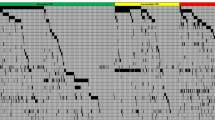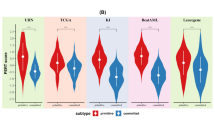Abstract
Background
Relapse in pediatric acute myeloid leukemia (pedAML) patients is known to be associated with residual leukemic stem cells (LSC). We have previously shown that epithelial membrane protein 1 (EMP1) is significantly overexpressed in LSC compared to hematological stem cell fractions. EMP1 was also documented as part of the 17-gene stemness score and a 6-membrane protein gene score, both correlating high EMP1 expression with worse overall survival. However, its potential as a therapeutic target in pedAML is still unexplored.
Methods
Association analyses of EMP1 expression with clinical and molecular AML characteristics were performed. Expression of EMP1 was evaluated in pedAML and cord blood samples. Expression in normal blood cells and tissues was evaluated by flow cytometry and immunohistochemistry, respectively.
Results
In silico analyses showed variable mRNA expression of EMP1 in multiple pedAML datasets, and a significant correlation between high EMP1 transcript levels and the presence of inv(16). Flow cytometry showed overexpression of EMP1 in pedAML samples, as well as expression in normal blood subsets. Importantly, immunohistochemistry revealed EMP1 expression in multiple normal tissues.
Conclusion
Although EMP1 presents as an interesting membrane-associated target in pedAML, its abundant expression in normal blood cells and tissues will impede it from further exploration as a therapeutic target.
Impact
-
EMP1 is highly expressed in multiple cancer types, but expression in acute myeloid leukemia (AML) and normal tissues is unexplored.
-
As EMP1 is investigated in other cancer types, expression in normal tissues and blood cells is relevant in predicting the success of EMP1-targeted therapies.
-
In this study, we showed expression of EMP1 in multiple tissues, predicting high on-target off-tumor toxicity, which will warn other researchers of possible toxicities when generating EMP1-targeted therapy.
-
Finally, we showed that high EMP1 expression is associated with better overall survival of pediatric AML patients, reducing the need for EMP1-targeted therapy.






Similar content being viewed by others
Data availability
All data generated or analyzed during this study are included in this published article [and its supplementary information files].
References
Zwaan, C. M. et al. Collaborative efforts driving progress in pediatric acute myeloid leukemia. J. Clin. Oncol. 33, 2949–2962 (2015).
Rasche, M. et al. Successes and challenges in the treatment of pediatric acute myeloid leukemia: a retrospective analysis of the AML-BFM trials from 1987 to 2012. Leukemia 32, 2167–2177 (2018).
Maloney, K. W. et al. Outcome in children with standard-risk B-cell acute lymphoblastic leukemia: results of children’s oncology group trial AALL0331. J. Clin. Oncol. 38, 602–612 (2020).
Stelmach, P. & Trumpp, A. Leukemic stem cells and therapy resistance in acute myeloid leukemia. Haematologica 108, 353–366 (2023).
Depreter, B. et al. Deciphering molecular heterogeneity in pediatric AML using a cancer vs. normal transcriptomic approach. Pediatr. Res. 89, 1695–1705 (2021).
Creutzig, U. et al. Diagnosis and management of acute myeloid leukemia in children and adolescents: recommendations from an international expert panel. Blood 120, 3187–3205 (2012).
Barlogis, V. et al. Late cardiomyopathy in childhood acute myeloid leukemia survivors: a study from the L.E.A. program. Haematologica 100, e186–e189 (2015).
Taylor, V., Welcher, A. A., Program, A. E. & Suter, U. Epithelial membrane protein-1, peripheral myelin protein 22, and lens membrane protein 20 define a novel gene family. J. Biol. Chem. 270, 28824–28833 (1995).
Ng, S. W. K. et al. A 17-gene stemness score for rapid determination of risk in acute leukaemia. Nature 540, 433–437 (2016).
Lin, S.-Y. et al. A 6-membrane protein gene score for prognostic prediction of cytogenetically normal acute myeloid leukemia in multiple cohorts. J. Cancer 11, 251–259 (2020).
Lange, B. J. et al. Outcomes in CCG-2961, a children’s oncology group phase 3 Trial for untreated pediatric acute myeloid leukemia: a report from the Children’s Oncology Group. Blood 111, 1044–1053 (2008).
Gamis, A. S. et al. Gemtuzumab ozogamicin in children and adolescents with de novo acute myeloid leukemia improves event-free survival by reducing relapse risk: results from the randomized phase III Children’s oncology group trial AAML0531. J. Clin. Oncol. 32, 3021–3032 (2014).
Pollard, J. A. et al. Sorafenib in combination with standard chemotherapy for children with high allelic ratio FLT3/ITD+ acute myeloid leukemia: a report from the children’s oncology group protocol AAML1031. J. Clin. Oncol. 40, 2023–2035 (2022).
Aplenc, R. et al. Bortezomib with standard chemotherapy for children with acute myeloid leukemia does not improve treatment outcomes: a report from the Children’s Oncology Group. Haematologica 105, 1879–1886 (2020).
Balgobind, B. V. et al. Evaluation of gene expression signatures predictive of cytogenetic and molecular subtypes of pediatric acute myeloid leukemia. Haematologica 96, 221–230 (2011).
Zhang, N. et al. Unraveling the structures, functions and mechanisms of epithelial membrane protein family in human cancers. Exp. Hematol. Oncol. 11, 69 (2022).
Ariës, I. M. et al. EMP1, a novel poor prognostic factor in pediatric leukemia regulates prednisolone resistance, cell proliferation, migration and adhesion. Leukemia 28, 1828–1837 (2014).
Wang, J. et al. EMP1 regulates cell proliferation, migration, and stemness in gliomas through PI3K-AKT signaling and CD4. J. Cell. Biochem. 120, 17142–17150 (2019).
Hsu, C.-H. et al. Transcriptome profiling of pediatric core binding factor AML. PloS One 10, e0138782 (2015).
Ichikawa, H. et al. Common gene expression signatures in t(8;21)-and inv(16)-acute myeloid leukaemia. Br. J. Haematol. 135, 336–347 (2006).
Acknowledgements
Our gratitude goes to all patients and their parents for their participation in the study, as well as to the data managers involved in the clinical trials. The authors thank the Cord Blood Bank, the staff of all the involved Pediatric Hematology and Oncology sites, and the Pathology Department of Ghent University Hospital (Ghent, Belgium) for providing samples. A special thanks to Irem Kaya for the sample preparation of the immunohistochemistry analysis. The results published here are in whole or partly based upon data generated by the Therapeutically Applicable Research to Generate Effective Treatments (https://www.cancer.gov/ccg/research/genomesequencing/target) initiative, phs000218. The data used for this analysis are available at the Genomic Data Commons (https://portal.gdc.cancer.gov).
Funding
This research was funded by Kom op tegen Kanker (grants to B.D.M. and T.L.), vzw Kinderkankerfonds (grant to B.D.M.), and the Olivia Hendrickx Research Fund (grant to L.V.C.).
Author information
Authors and Affiliations
Contributions
Conceptualization, L.V.C., B.D., T.L. and B.D.M.; methodology, L.V.C., J.D.W., M.H., M.V.D.L., E.T., and T.L.; formal analysis, L.V.C.; resources, A.U., A.V.D., L.D., C.C., T.L. and B.D.M.; writing—original draft preparation, L.V.C.; writing—review and editing, all authors; supervision, T.L and B.D.M.; funding acquisition, L.V.C., B.D.M. and T.L. All authors have read and agreed to the published version of the manuscript.
Corresponding author
Ethics declarations
Competing interests
All authors declare to have no potential conflicts of interest. The funders had no role in the design of the study; in the collection, analyses, or interpretation of data; in the writing of the manuscript; or in the decision to publish the results.
Consent Statement
The study was conducted according to the guidelines of the Declaration of Helsinki and approved by the Institutional Review Board (or Ethics Committee) of the Ethics Committee of the University Hospital of Ghent (EC2015-1443 1 April 2016 and EC2019-0294 20 March 2020). Informed consent was obtained from all subjects involved in the study.
Additional information
Publisher’s note Springer Nature remains neutral with regard to jurisdictional claims in published maps and institutional affiliations.
Supplementary information
Rights and permissions
Springer Nature or its licensor (e.g. a society or other partner) holds exclusive rights to this article under a publishing agreement with the author(s) or other rightsholder(s); author self-archiving of the accepted manuscript version of this article is solely governed by the terms of such publishing agreement and applicable law.
About this article
Cite this article
Van Camp, L., Depreter, B., De Wilde, J. et al. Acute myeloid leukemia stem cell signature gene EMP1 is not an eligible therapeutic target. Pediatr Res (2024). https://doi.org/10.1038/s41390-024-03341-x
Received:
Revised:
Accepted:
Published:
DOI: https://doi.org/10.1038/s41390-024-03341-x
- Springer Nature America, Inc.




